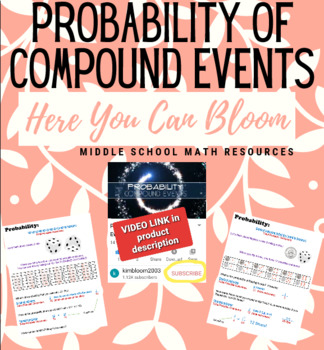Probability of Compound Events VIDEO & HINT CARDS for Virtual Learning.
Here you can BLOOM
969 Followers
Grade Levels
6th - 8th
Subjects
Resource Type
Standards
CCSS7.SP.C.5
CCSS7.SP.C.6
CCSS7.SP.C.7
CCSS7.SP.C.7a
CCSS7.SP.C.7b
Formats Included
- Zip
Here you can BLOOM
969 Followers
Description
Hint Cards for probability of compound events (including dice, marbles, and coins) with easy to follow along VIDEO explaining the hint cards.
Click here for video --> Probability of Compound Events Video
Hint Cards in PDF & Word Format.
Total Pages
Answer Key
N/A
Teaching Duration
N/A
Report this resource to TPT
Reported resources will be reviewed by our team. Report this resource to let us know if this resource violates TPT’s content guidelines.
Standards
to see state-specific standards (only available in the US).
CCSS7.SP.C.5
Understand that the probability of a chance event is a number between 0 and 1 that expresses the likelihood of the event occurring. Larger numbers indicate greater likelihood. A probability near 0 indicates an unlikely event, a probability around 1/2 indicates an event that is neither unlikely nor likely, and a probability near 1 indicates a likely event.
CCSS7.SP.C.6
Approximate the probability of a chance event by collecting data on the chance process that produces it and observing its long-run relative frequency, and predict the approximate relative frequency given the probability. For example, when rolling a number cube 600 times, predict that a 3 or 6 would be rolled roughly 200 times, but probably not exactly 200 times.
CCSS7.SP.C.7
Develop a probability model and use it to find probabilities of events. Compare probabilities from a model to observed frequencies; if the agreement is not good, explain possible sources of the discrepancy.
CCSS7.SP.C.7a
Develop a uniform probability model by assigning equal probability to all outcomes, and use the model to determine probabilities of events. For example, if a student is selected at random from a class, find the probability that Jane will be selected and the probability that a girl will be selected.
CCSS7.SP.C.7b
Develop a probability model (which may not be uniform) by observing frequencies in data generated from a chance process. For example, find the approximate probability that a spinning penny will land heads up or that a tossed paper cup will land open-end down. Do the outcomes for the spinning penny appear to be equally likely based on the observed frequencies?




